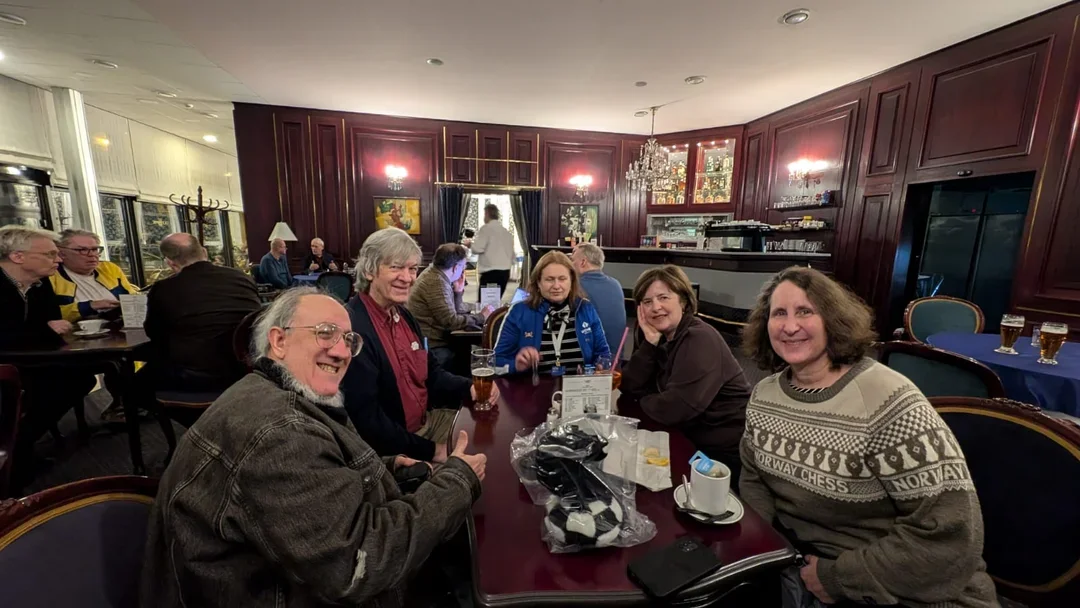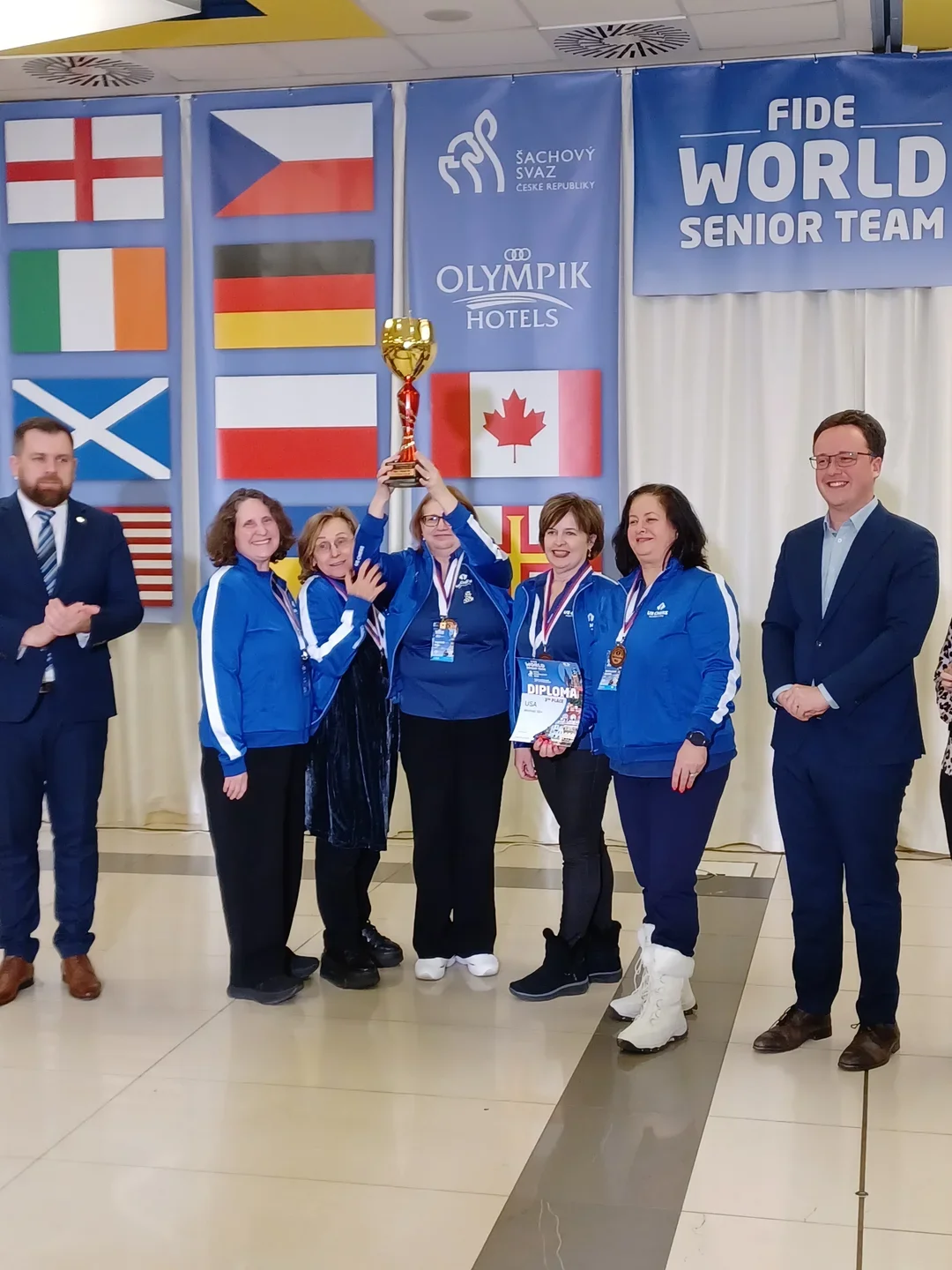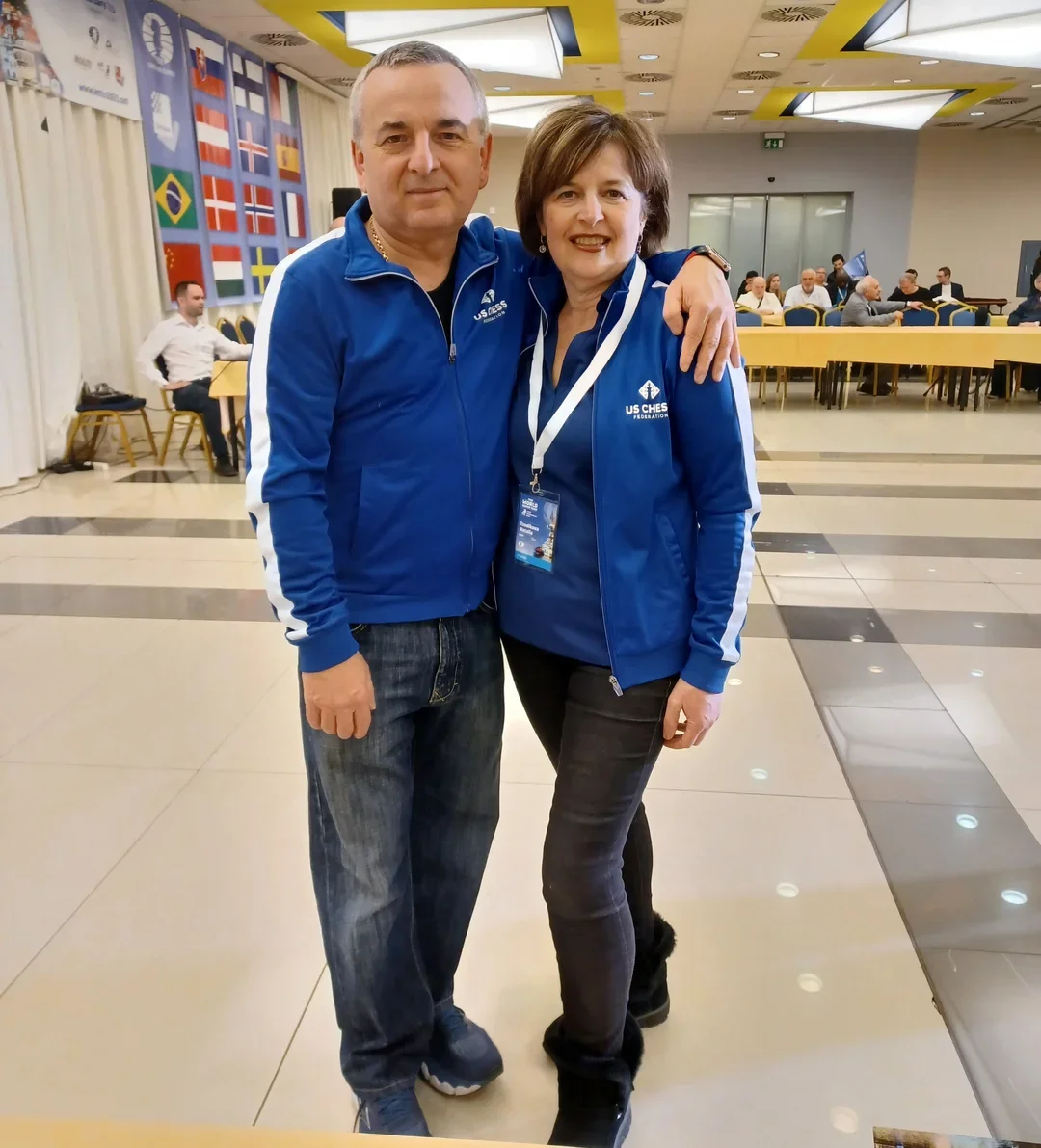Editor’s note: We continue our coverage of the 2025 FIDE World Senior Team Championship with a report from USA Women’s fourth board, WIM Alexey Root. Yesterday’s recap charts USA’s path to gold in the 50+ section.
Our focus in these reports is on the 50+ section because both US Chess-sponsored teams competed in the 50+ section. But because this report mentions the standings in the 65+ category’s women’s race, I also wanted to congratulate England 1 for its win in the 65+ section. Led by GM John Nunn, the reigning champions yielded only two draws on the way to their championship, finishing ahead of two German teams (Lasker Schachstiftung GK and Saxonia).
The FIDE World Senior Team Chess Championship ran from February 16–27 in Prague, Czech Republic. There were 54 teams in the 50+ category and 54 teams in the 65+ category. Within each category, teams composed of women players were eligible for medals reserved for women’s teams.
65+ Category: Winning Women’s Teams
In the 65+ category, three teams competed for first, second, and third places among women’s teams. Latvia Women took gold, Czech Republic Women took silver, and Poland Women took bronze.
At the start of the event, Latvia Women ranked 37th (of 54 teams), Czech Republic Women ranked 43rd, and Poland Women ranked 52nd. Latvia Women finished with the same match points and game points as Czech Republic Women. A fourth tiebreak method decided which team got first and which team got second.
50+ Category: Winning Women’s Teams
In the 50+ category, five women’s teams vied for three medals. The China Women began the event ranked 12th (of 54 teams) in the 50+ category. Initially, Czech Republic Women ranked 25th, USA Women were 26th, England Women were 30th, and Kazakhstan Women ranked 32nd.
At the end of the event, Czech Republic Women and China Women tied with 10 match points each. But Czech Republic Women had 18½ game points, topping China Women’s 18 game points. Therefore, Czech Republic Women took the gold medal. China Women took silver, and USA Women earned bronze.

Although how teams finished mostly corresponded to their initial rankings, each round had its twists and turns. Even pre-tournament decisions had repercussions.
Round-by-Round Recap
"I never defeated a healthy opponent."
The statement "I never defeated a healthy opponent” is sometimes attributed to Tartakower. It means that many players don’t admit that they lost because they made errors. Or because their opponents outplayed them. Instead, they blame their losses on being ill.
I visited my granddaughter on Wednesday, February 12. I had been warned that she was experiencing vomiting and diarrhea. But I felt fine after spending three hours with her. Then on Thursday night, February 13, those symptoms began for me. On the 14th, I flew to Europe arriving in Prague on the evening of the 15th.
Round 1
In round 1, our team played at the Hotel Olympik Congress, where all of the 65+ matches happened. Only the lowest four matches of the 50+ category were assigned to the Congress, which was a short walk from our Hotel Olympik.
Because of my stomach bug, I could not play round 1 as our team captain Olga Sagalchik had planned. Sagalchik had hoped to take that round off, as she was the last member of our team to arrive in Europe.
Sagalchik arrived at Hotel Olympik midday on the 16th, and her luggage arrived around nine hours later. Still, Sagalchik played, drawing her game. Our other three players won, securing our 3½–½ victory against Jawa 2025.
Round 2
In round 2 we played China Women. Sagalchik sat out. I felt well enough to play on board 3, and prepared based on one of her previous games in the database. Still, I was relieved when my higher-rated opponent offered a draw after just 12 moves.
My opponent’s offer was strategic: Our alternate, Ivona Jezierska, was losing on board 4. Our first and second boards received, and accepted, draw offers too. We lost the match 1½–2½.

I had been eating a bland diet, to recover from my stomach bug. This diet was easy to implement, as each buffet-style meal at the Hotel Olympik included bread. Lunch and dinner always included dishes made out of potatoes, such as French fries or mashed potatoes. Plain pasta or white rice was usually offered too.
Since Anjelina Belakovskaia (our board 1) and I finished our games early, we walked, along with Anjelina’s 18-year-old son Connor, to Cafe Imperial for dinner. At Cafe Imperial, I ate dill soup and goat cheese salad. Though I loved socializing with my teammate and her son, straying from my bland diet was a mistake. I had a rough night.
Round 3
At the start of round 3, an arbiter announced that the Finnish team captain Ari Issakainen, age 63, died in his sleep the night before. After the arbiter read a statement about Issakainen, composed by his teammates, players observed a moment of silence.
I lost on board 3, and Jezierska won on board 4. Belakovskia had taken the round off. Filling in for her on board 1 was Natalia Tsodikova, who drew. Sagalchik drew on board 2. Thus, USA Women tied our match, 2–2, with ŠK Bohemia Pardubice.
Round 4
USA Women won 2½–1½ over Sachsenwölfe. Playing her first game as White, Tsodikova won in nine moves on board 2. Both she and her opponent thought her winning a queen for two pieces was decisive. But Stockfish 17 thinks Black is slightly better at the point where he resigned.
After her win, Tsodikova was taken to a separate room for a fair play screening. The arbiters had warned that, post-game, any player could randomly be selected for this procedure. Tsodikova told us that she had to remove her shoes during the screening.
On board 4, Jezierska’s opponent offered her a draw when Jezierska felt she was better. So, she refused and later sacrificed on h7 (unsoundly). She got her piece back and, in retrospect, should have offered a draw at that point. Instead, she played on and lost. Stockfish 17 evaluated Belakovskaia’s position as +5 for her opponent. Her opponent overlooked the best plan of attack and Belakovskaia, as Black, held a draw. On board 3, Sagalchik won.
Round 5
I was completely healthy by round 5. Yet I lost, again. Sagalchik’s draw on board 3 seemed solid. Board 1 Belakovskaia and board 2 Tsodikova were in trouble, but their opponents offered them draws. Scotland 2 was content to win against USA Women with 2½–1½.
Rest Day
Sagalchik, Tsodikova, and I toured Prague Castle, the largest coherent castle complex in the world. It has an area of almost 70,000 square meters. Then we visited Old Town Prague, with the Prague Astronomical Clock as one highlight. We walked over 15,000 steps.

In the evening, the three of us, plus Belakovskaia and Jezierska, socialized at the Hotel Olympik bar with two members of the United States team in the 65+ category, board 3 Lawrence Cohen and board 2 Kenny Thomas.

US Chess sponsored both the USA Women 50+ team and the USA 50+ team. The United States team in the 65+ category, which also had board 1 and captain Bob Holliman and fourth board William Montross, was self-funded. Also self-funded was the U.S.A. 5 Brothers team, all with the last name of Jhunjhnuwala, which competed in the 50+ category. Both of those teams gave our team gifts of custom-made pins, for which we were thankful.
Round 6
In my last game for USA Women, I lost on board 3. I missed a chance to equalize on move 35.
The USA Women tied 2–2 against SC Roter Turm Altstadt. On board 1, Belakovskaia drew. On board 2, Sagalchik drew. Tsodikova took this round off. On board 4, Jezierska won.
Jezierska was searched immediately after her win, our team’s second encounter with post-game fair play screening. Before each round, every player was “wanded” and all bags were searched. No pens, phones, smart watches (etc.) could come into the playing hall.
Round 7
In round 7, Belakovskaia suffered her first loss. While in Prague, Belakovskaia kept up with her duties as an Associate Teaching Professor in Global Finance at the Thunderbird School of Global Management, Arizona State University. She held office hours and taught most weeknights. With the time difference, her office hours usually began around 9:30 p.m. and her teaching began at either 11 p.m. or 2:00 a.m.
Boards 2, 3, and 4, played respectively by Tsodikova, Sagalchik, and Jezierska, won. USA Women 50+ scored 3–1 against Equipe Quebec.
Round 8
After she played an unusual opening (1. … g5), Belakovskaia equalized as Black against Denmark’s first board, GM Jacob Aagaard. When board 2 (Tsodikova) and board 4 (Jezierska) drew, and board 3 (Sagalchik) lost, Belakovskaia felt she had to try for lines with winning chances. A win by her would tie the match. In time trouble, Belakovskaia erred and lost. Denmark won 3–1 against USA Women.
Round 9
Going into Round 9, USA Women trailed behind Czech Republic Women and China Women in match points. Both of those teams had 10 match points. USA Women had eight match points, as did England Women and Kazakhstan Women.
The scoring is two points for winning a match, one point for tying a match, and zero points for losing a match. Match points are paramount, though if two teams tie in match points, game points are a tiebreaker.
Going into round 9, Czech Republic Women had 17½ game points, China Women had 17, USA Women had 17, England Women had 15, and Kazakhstan Women had 14½. If USA Women won its match against the Philidor Brothers, we would move to 10 match points. Then, if Czech Republic Women and China Women lost their ninth-round matches, USA Women would come out ahead of them on the game points tiebreaker.
But the Philidor Brothers, a team from France, tied USA Women 2–2. On board 1 Belakovskaia drew. After Sagalchik drew on board 3, arbiters examined Sagalchik in another random fair play post-game screening.
On board 2, Tsodikova won. The last game to finish was board 4; Jezierska lost. The USA Women moved from 8 to 9 match points. The other women’s teams lost their round 9 matches, leaving USA Women in clear third.

Board Prize and Blitz
Tsodikova was the top woman performer on board 2. She also was the 15th best performer overall on board 2, with a 2217 FIDE performance. Tsodikova’s husband and coach, IM Rost Tsodikov, finished in 12th place in the Blitz, the second-highest USA performer in that side event held on the rest day. The USA’s GM Jaan Ehlvest won the Blitz.

Going for the Gold
Thank you to team captain Sagalchik, who kept USA Women organized and motivated with team breakfasts, evening meetings, and a lively WhatsApp group. Sagalchik also stayed until the end of each of our matches. Thank you to my three other teammates — Belakovskaia, Tsodikova, and Jezierska — who were kind, funny, and encouraging. It was an honor for me to be your teammate.
Thank you to US Chess for sponsoring the USA Women 50+ team. In 2024, USA Women 50+ won silver and in 2025 we won bronze. There are two ways to look at this year’s result. One is that USA Women are trending downward. But that’s not true, as the competition in 2025 was tougher than in 2024. The correct way to look at the result is that we now need only one medal color — gold — to complete our podium collection.
Categories
Archives
- December 2025 (5)
- November 2025 (29)
- October 2025 (39)
- September 2025 (27)
- August 2025 (29)
- July 2025 (43)
- June 2025 (25)
- May 2025 (24)
- April 2025 (29)
- March 2025 (29)
- February 2025 (20)
- January 2025 (24)
- December 2024 (34)
- November 2024 (18)
- October 2024 (35)
- September 2024 (23)
- August 2024 (27)
- July 2024 (44)
- June 2024 (27)
- May 2024 (31)
- April 2024 (51)
- March 2024 (34)
- February 2024 (25)
- January 2024 (26)
- December 2023 (29)
- November 2023 (26)
- October 2023 (37)
- September 2023 (27)
- August 2023 (37)
- July 2023 (47)
- June 2023 (33)
- May 2023 (37)
- April 2023 (45)
- March 2023 (37)
- February 2023 (28)
- January 2023 (31)
- December 2022 (23)
- November 2022 (32)
- October 2022 (31)
- September 2022 (19)
- August 2022 (39)
- July 2022 (32)
- June 2022 (35)
- May 2022 (21)
- April 2022 (31)
- March 2022 (33)
- February 2022 (21)
- January 2022 (27)
- December 2021 (36)
- November 2021 (34)
- October 2021 (25)
- September 2021 (25)
- August 2021 (41)
- July 2021 (36)
- June 2021 (29)
- May 2021 (29)
- April 2021 (31)
- March 2021 (33)
- February 2021 (28)
- January 2021 (29)
- December 2020 (38)
- November 2020 (40)
- October 2020 (41)
- September 2020 (35)
- August 2020 (38)
- July 2020 (36)
- June 2020 (46)
- May 2020 (42)
- April 2020 (37)
- March 2020 (60)
- February 2020 (38)
- January 2020 (45)
- December 2019 (34)
- November 2019 (35)
- October 2019 (42)
- September 2019 (45)
- August 2019 (56)
- July 2019 (44)
- June 2019 (35)
- May 2019 (40)
- April 2019 (48)
- March 2019 (61)
- February 2019 (39)
- January 2019 (30)
- December 2018 (29)
- November 2018 (51)
- October 2018 (45)
- September 2018 (29)
- August 2018 (49)
- July 2018 (35)
- June 2018 (31)
- May 2018 (39)
- April 2018 (31)
- March 2018 (26)
- February 2018 (33)
- January 2018 (30)
- December 2017 (26)
- November 2017 (24)
- October 2017 (30)
- September 2017 (30)
- August 2017 (31)
- July 2017 (28)
- June 2017 (32)
- May 2017 (26)
- April 2017 (37)
- March 2017 (28)
- February 2017 (30)
- January 2017 (27)
- December 2016 (29)
- November 2016 (24)
- October 2016 (32)
- September 2016 (31)
- August 2016 (27)
- July 2016 (24)
- June 2016 (26)
- May 2016 (19)
- April 2016 (30)
- March 2016 (36)
- February 2016 (28)
- January 2016 (32)
- December 2015 (26)
- November 2015 (23)
- October 2015 (16)
- September 2015 (28)
- August 2015 (28)
- July 2015 (6)
- June 2015 (1)
- May 2015 (2)
- April 2015 (1)
- February 2015 (3)
- January 2015 (1)
- December 2014 (1)
- July 2010 (1)
- October 1991 (1)
- August 1989 (1)
- January 1988 (1)
- December 1983 (1)







